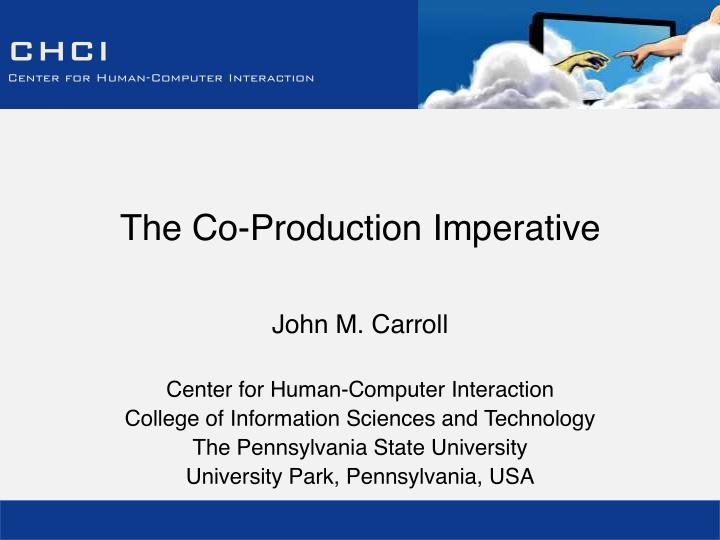



CHCI � Center for Human-Computer Interaction � The Co-Production Imperative � John M. Carroll � � Center for Human-Computer Interaction � College of Information Sciences and Technology � The Pennsylvania State University � University Park, Pennsylvania, USA �
What is Co-production? � • Services are co-produced when provider and recipient contribute reciprocally to the success of the service � CHCI 2 OF 7 J.M. C ARROLL
Get to The Point � • Service co-production is an important model for understanding services at the level of facilitating and coordinating human activity � • From the standpoint of human beings, service co-production is moral, efficient, and innovative relative to service provision � • Therefore … � • The science and technology of services should better understand and facilitate co-production of services � CHCI 3 OF 7 J.M. C ARROLL
Origins � • Jane Jacobs, Death and Life of Great American Cities (1961) � – Elderly neighbors who rarely go out keep us safe � • Elinor Ostrom, coined term in early 1970s � – Chicago police leaving the beat for patrol cars increase crime � • Edgar Cahn, No More Throwaway People (2000) � – Timebanks unmarginalize recipients of social services � • British National Health Service (NHS) � – Timebank services support aging-in-place, and prescribed as treatment for mood disorders � CHCI 4 OF 7 J.M. C ARROLL
Invisible, pervasive, effective � • The invisible something that makes services work � • Some services can only ever succeed as co- productions � – E.g., any service involving learning, emotion, health and well-being, social support, … (a lot of services) � • Designing hyper-efficient services � – Person “receiving” the NHS service earns time dollars by being “treated” (for free!) � – P2P service microenterprises capitalize “wasted” resources and opportunities � CHCI 5 OF 7 J.M. C ARROLL
Designing Service Co-production � • Identify the active role of the “recipient” in creating service outcomes � – scenarios, personas vs. service blueprinting � • Focus on breakdown and workaround from the recipient’s point of view � – services appropriable by recipients vs. customer journey maps � • Probe, articulate and refine the recipient’s experience of the service � – Role play, service experience prototypes vs enumerating touch-points � CHCI 6 OF 7 J.M. C ARROLL
Thank you! � Comments, questions, suggestions � CHCI 7 OF 7 J.M. C ARROLL
Recommend
More recommend